Eighth First Lady of the United States
Hannah Hoes Van Buren was the wife of U.S. President Martin Van Buren. She was the first president’s wife to be born a U.S. citizen and not as a subject of the British crown. Because she died eighteen years before Van Buren became President (1837-1841), she is one of the most obscure of our First Ladies. Van Buren never remarried and was one of the few Presidents to be unmarried while in office. His new daughter-in-law Angelica Singleton Van Buren presided as the lady of the White House from 1839 until the end of his term.
Hannah Hoes was born on March 8, 1783 in Kinderhook, New York to Johannes Dircksen Hoes and Maria Quakenbush Hoes who were of Dutch ancestry, and was raised on her family’s farm. Hannah was taught in a local Kinderhook school by master Vrouw Lange. Dutch was her first language and she never lost her distinct Dutch accent.
All of Hannah’s ancestors were from Holland, the last immigrating to New York Colony after 1675. Through both paternal and maternal lines, Hannah Hoes and Martin Van Buren were cousins in a close-knit Dutch community, their ancestors all coming from Kinderhook. Through her mother, Maria Quakenbush, Hannah was related to Elizabeth Monroe (wife of President James Monroe), the Roosevelts and a distant cousin of Martin Van Buren’s mother.
No documentation of her life previous to her marriage exists; it is highly likely that Hannah lived as all residents of the insular community of Kinderhook did, speaking Dutch with their fellow townspeople and English with outsiders and tending to the chores of a rural life in an isolated Hudson River community.
Hannah Hoes and Martin Van Buren grew up together in Kinderhook, New York. When he left town at age 20 to study law and clerk at an attorney’s office in New York City, Hannah remained with her family in Kinderhook. They did not marry immediately upon his return but waited until he had first established a law practice with his half-brother.
Marriage and Family
Hannah Hoes and Martin Van Buren were married on February 21, 1807 at the home of the bride’s sister in Catskill, New York, when he was 24 and his bride just three months younger. The couple settled in Kinderhook. Van Buren was devoted to his shy, blue-eyed, blond-haired bride, whom he always called “Jannetje,” a Dutch form of Hannah.
Apparently their marriage was a happy one, though little is known of Hannah as a person. Hannah gave birth to six children within ten years: a daughter who was stillborn and a son who died in infancy, and four sons who survived to adulthood: Abraham (1807-1873), John (1810-1866), Martin Jr. (1812-1855) and Smith Thompson (1817-1876).
A year after their marriage, Hannah and Martin Van Buren moved from Kinderhook to the larger nearby town of Hudson, New York, where Martin was appointed as county attorney and became involved in the local Democratic Party.
When Van Buren was elected to the New York State Senate in 1812, Hannah and the family moved to Albany, New York, the state capital. Soon the household included Van Buren’s law partner and three apprentices who lived with the family; relatives came and went constantly and Hannah returned their visits. Contemporary letters indicate that she was busy, sociable and happy.
However, Hannah’s main focus was on raising her sons and her church. Coming from a strong religious background, Hannah also devoted herself to the charitable efforts of the local Presbyterian Church, because there was no Dutch Reformed Church in Albany. She supported outreach works that more “fashionable” ladies objected to because of the society such outreach might bring into the church.
Hannah was slow to recover from the birth of her fifth child in January 1817. By the following winter it was obvious that her health was failing, apparently from tuberculosis.
Hannah Van Buren died in Albany on February 5, 1819, at age 35. Her service was held at the Dutch Reform Church in Kinderhook with interment in the church cemetery. At Hannah’s request, the custom of providing scarves for the pallbearers to wear at the funeral was abandoned and the money set aside to pay for them was used to feed the poor.
Martin Van Buren was the eighth Vice President (1833–1837) and the tenth Secretary of State under Andrew Jackson (1829–1831). As Jackson’s Secretary of State and then Vice President, he was a key figure in building the organizational structure for Jacksonian democracy, particularly in New York State.
Martin Van Buren was elected as the eighth President of the United States (1837–1841). He had not remarried, and moved into the White House as a fifty-four year old widower with four bachelor sons, who became known in Washington as The Van Buren Boys.
The eldest, Abraham, had graduated West Point and served as personal secretary to his father. John was a Yale graduate, a lawyer and later U.S. Congressman, who became one of the most outspoken pre-Civil War opponents of slavery.
Martin Van Buren Jr. was a student of political science and history, and served as a political aide to his father and compiled the information used by the President in writing his memoirs. The youngest son, Smith Thompson, also served as a political aide to his father and drafted many of his speeches. He married Henrietta Irving, a niece of short-story writer Washington Irving.
Now accustomed to living in elegant style, Van Buren immediately began to refurbish a mansion that was shabby from public use under Jackson. For the first year and eight months of the Martin Van Buren presidency, there was no First Lady in the White House.
Across Lafayette Square, former First Lady Dolley Madison reigned as matriarch of Washington society; when her young cousin Angelica Singleton came up from South Carolina for a visit, Dolley introduced her to Washington society, including an 1837 dinner at the White House with the President and his eldest son Abraham.
Angelica and Abraham Van Buren married a year later, in November 1838. The President reportedly approved of the marriage and the ties it brought between the White House and the Southern aristocracy. As a northern Democrat, he was caught between the abolitionist sentiments of the New York machine that had elected him and the rising hostility of southern Democrats who resolved to ensure that slavery continued to support their agrarian economic system.
After an extended European honeymoon Angelica Singleton Van Buren returned in 1839 with her husband to live at the White House, where Abraham continued his role as his father’s private secretary. Angelica served as White House hostess until Van Buren’s term ended in March 1841, and was clearly an asset to her father-in-law’s administration. The only flaw in her pleasure in this role was the loss of a baby girl who lived only a few hours.
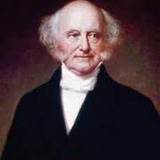
Image: Martin Van Buren in 1858
By George Peter Alexander Healy
Unfortunately, President Van Buren’s administration was largely characterized by the economic hardship of his time, the Panic of 1837, followed by a five-year depression, with the failure of banks and record-high unemployment levels. “Martin Van Ruin” was scapegoated for the worst economic crises in history. He was voted out of office after four years, losing to William Henry Harrison.
Martin Van Buren then retired to his home in Kinderhook, where he died July 24, 1862.
Hannah Van Buren did not live to see her husband become president or to see her sons serve in important political positions, but her presence was felt during the Van Buren presidency. Her adult sons reflected the excellent upbringing they received from her, and her name appears on the White House official list of First Ladies.
Though her husband had said that Hannah was the guiding force in his life, she was never mentioned in President Van Buren’s 800 page autobiography. Apparently Van Buren believed that gentleman of that day would not shame a lady by public references. A niece who remembered “her loving, gentle disposition” emphasized “her modest, even timid manner.”
SOURCES
Wikipedia: Hannah Van Buren
First Lady Biography: Hannah Van Buren
The White House: Hannah Hoes Van Buren

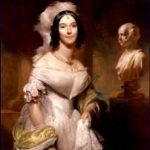
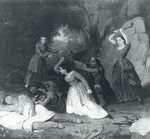
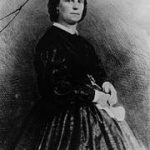
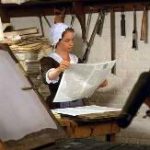

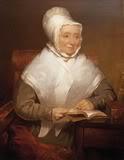
Hannah Hoes was never First Lady. She died before her husband became President.